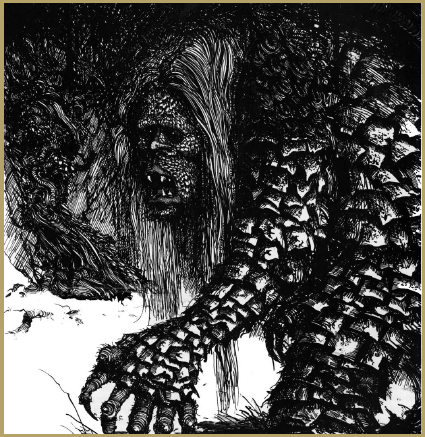TROLLS OF ANGBAND

Just as Tolkien’s Balrogs were inspired by the legends of the fire giants of Muspelheim, the Norse region of fire, so we find Tolkien’s Trolls were inspired by the stone and frost giants of Jotunheim (Old Norse: Jötunheimr), the Norse region of darkness and cold. In the inhabitants of this “Land of the Giants” – known as jötnar (jötunn is the singular) – we see the recognizable characteristics of the powerful but frequently outwitted trolls and ogres of later Germanic and Scandinavian legends and fairy tales.
Huge humanoid monsters, trolls and ogres can be discovered in folklore and legends in every region of the world. They have left their footprints all over the landscape, moved mountains and changed the courses of rivers. In many folk tales, large standing stones are believed to be trolls that have been turned to rock after being exposed to sunlight. Like Tolkien’s Trolls, they are creatures of darkness, preferring to live in mountain caverns or forest caves, where they often prey on lost children and unwary travellers.
In traditional fairy tales, trolls and ogres are mostly solitary monsters lurking in dark places. This is also true of many of Tolkien’s Trolls, who are simply content with random and brutal acts of mayhem and mischief. However, Tolkien’s many epic tales of armies of Trolls allied with Balrogs and Dragons in cataclysmic battles with the Valarian “gods” found much more inspiration in the Norse legends of armies of jötnar allied with fire giants and dragons in cataclysmic battles with the Norse gods of Asgard.
The word “troll” comes from an Old Norse word meaning fiend, demon or jötunn. The origin of trolls is not known, although it should be noted that, in Beowulf, the monster Grendel is a “water-haunting troll” who is descended from the cursed clan of the biblical murderer Cain. Tolkien’s Trolls appear to have been bred from captured and tortured giant Tree-herds. However, the resulting slow-witted and cursed offspring prove to be a mockery of the wise and noble Ents. In many of their aspects, Tolkien drew his creatures from the trolls of the darker Scandinavian fairy tales, where they are manifestations of the giant spirits of mountains and forests. Even if some extraordinary Scandinavian trolls are taller than mountains and have fir trees growing out of their heads, most are closer to Tolkien’s conception – brutal giants measuring roughly twice the height and three times the bulk and weight of humans. In Tolkien, these creatures are described as having a rock-hard skin of green scales. In common with fairy-tale trolls and ogres, Tolkien’s Trolls are cannibals who feast on human flesh – although, on Middle-earth, one must assume that Dwarf and Elf flesh was also a staple of the Troll diet.

Stone Troll
Fairy-tale trolls are not immune to the vice of avarice, and hoard the treasures and trophies taken from their victims. Troll hoards also appear relatively frequently in Middle-earth, where, beyond furnishing adventurers with fabulous wealth, they also opportunely provide several of Tolkien’s heroes with ancient Elven swords and daggers. Similar discoveries frequently appear to have provided many German and Norse epic heroes with their own magical weapons.
The stupidity of trolls is all but universal in legends and fairy tales. This is consistent with Tolkien’s Trolls: many, we learn, could not be taught speech at all, while others could learn only the barest rudiments of the Black Speech of Orcs. A frequent theme in traditional fairy tales and trickster folklore – and repeated in Tolkien’s writing – involves a clever hero tricking or swindling a dull-witted troll out of his treasure. If it were not for their little faults – like murder and cannibalism – one might almost feel sorry for these mentally challenged creatures.
